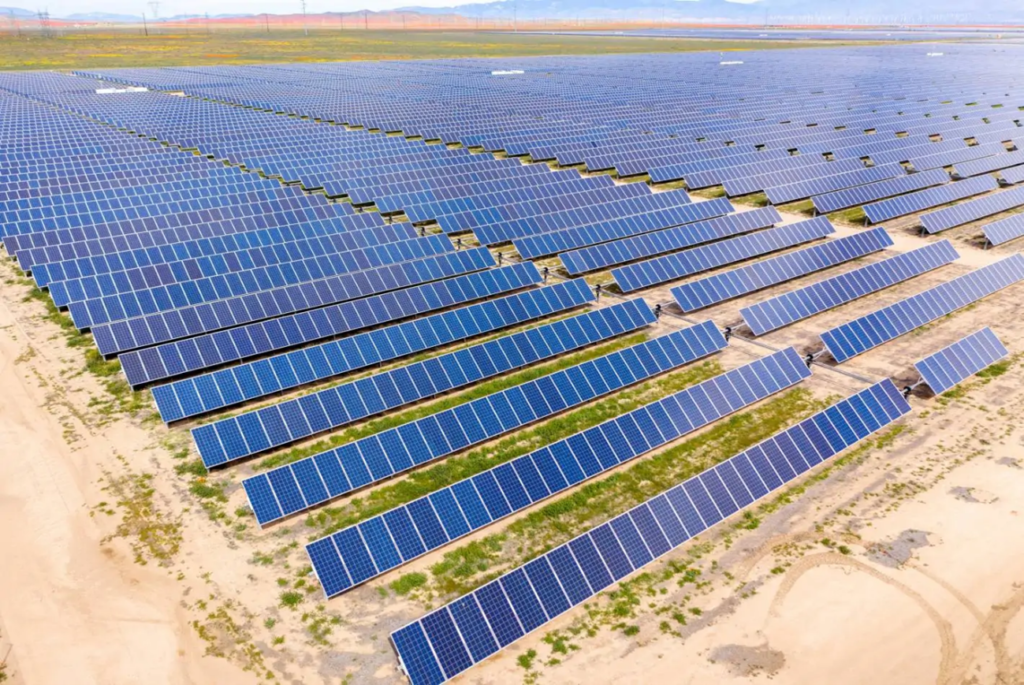
Solar farm. Image: Infrastructure Pipeline
By James Myers
Humans have been making electricity from the sun, in a process called the photovoltaic effect, for nearly two centuries.

Edmond Becquerel, 1820-1891. Image: Wikipedia
The world’s first solar cell was created by physicist Edmond Becquerel in 1839 when, at the age of 19, he discovered that electricity can be generated by exposing platinum electrodes coated with silver chloride or silver bromide to the sun.
While it demonstrated the sun’s potential, Becquerel’s solar cell wasn’t an efficient producer of electricity. Interest in solar as a major source of energy would have to wait until the economic shock of the 1973 oil embargo, and the more recent global focus on renewable energy to address the climate crisis.
The efficiency of solar cells continues to increase and their cost of manufacturing has decreased significantly, particularly in the last decade. Most cells are now made primarily of silicon, and on average convert about 22% of the sun’s energy into electricity. Increased efficiencies in electrical output and the manufacturing process have dramatically reduced the cost of producing a watt of electricity from the sun. However, solar energy production is yet to become widespread for home and industrial use, as it accounts for only about 4,5% of electrical generation in the world.
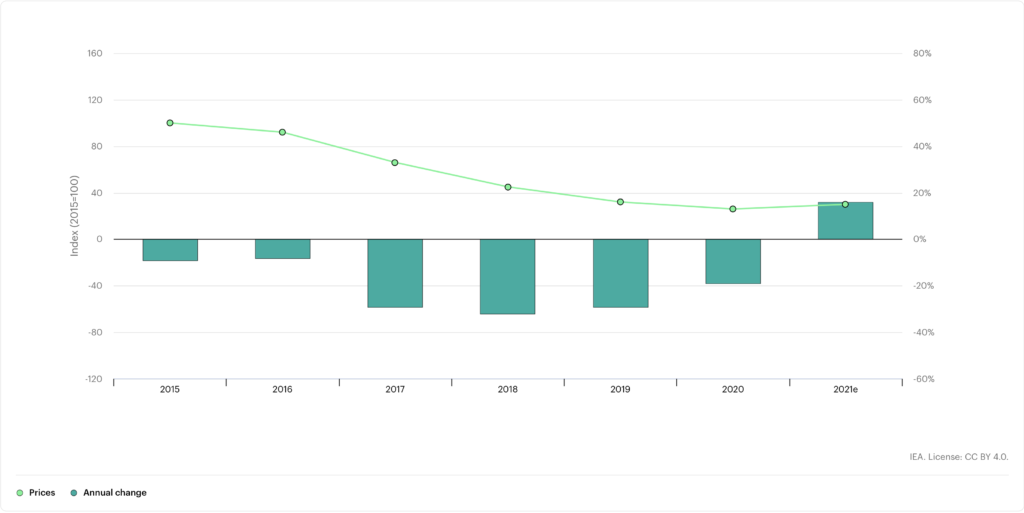
The cost of solar photovoltaic cells has decreased over 80% since 2015. International Energy Agency.
“Solar remains the third largest renewable electricity technology behind hydropower and wind — but it accounted for just 4.5% of total global electricity generation in 2022. To meet net-zero targets, solar capacity must therefore increase by 20% every year until 2030. Although it’s currently on track to meet that target, the industry still faces challenges.” – International Energy Forum.
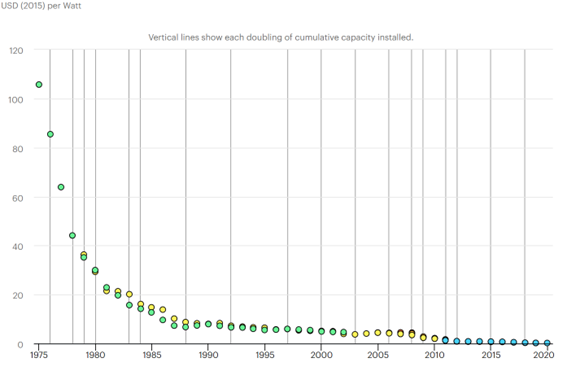
Evolution of solar PV module cost by data source, 1970-2020. Credit: International Energy Agency’s Clean Energy Innovation.
Physicists at the University of Oxford are experimenting with a technique that could double the average efficiency of solar power to as much as 45%.
Their method would replace silicon-based solar panels with a very thin, flexible coating of multiple light-absorbing layers that can be applied to the surface of a building, car, or everyday object like a backpack or mobile phone. Only one micron thick, the new material is about 150 times thinner than a silicon wafer in traditional solar cells, and is extremely versatile.
The University of Oxford researchers are part of a team of 40 led by Professor of Renewable Energy Dr. Henry Snaith, and will be publishing a scientific report on their findings later this year. After five years of experimentation, their material has been independently certified to provide 27% energy efficiency, already near the maximum of existing solar cell technology.
The ultra-thin photovoltaic material is based on the mineral perovskite, which is a calcium titanium oxide that can hold many different net positive electric charges. The wavelengths of light absorbed by perovskite differ from those absorbed by silicon, and when both materials combine in solar cells they utilize more of the sun’s light spectrum and produce more electricity per cell.
Perovskite is also the basis of the most efficient quantum dot (QD) solar cell, announced by researchers led by Professor Sung-Yeon Jang from the School of Energy and Chemical Engineering at the Ulsan National Institute of Science and Technology in South Korea. Quantum dots are particles so tiny that instead of their chemical properties being determined the number of electrons, as is the case with chemical elements, their characteristics – and importantly their colours – are determined by their size.
“Our developed technology has achieved an impressive 18.1% efficiency in QD solar cells,” stated Professor Jang. “This remarkable achievement represents the highest efficiency among quantum dot solar cells recognized by the National Renewable Energy Laboratory (NREL) in the United States.”
For quantum dots to operate in solar cells, they must be bound to a larger molecule. QD’s are normally bound to an inorganic molecule, but the research team achieved the efficiency breakthrough by developing a method to bind the QD’s to an organic molecule which is also stable and able to produce electricity after as much as two years in storage.
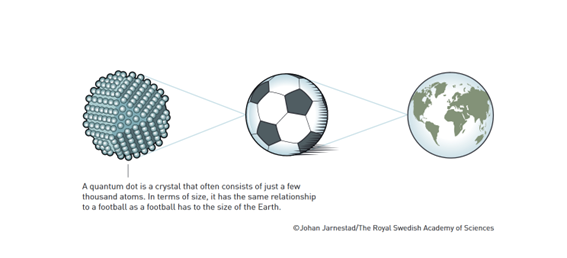
Illustration of quantum dot size relative to a soccer ball relative to the Earth. Image: Johan Jarnestad/The Royal Swedish Academy of Sciences
The discovery and development of quantum dots was the basis for the 2023 Nobel Prize in Chemistry, awarded to Moungi Bawendi, Louis Brus, and Aleksey Yekimov. Quantum dot nanoparticles with unique light-absorbing and emitting properties are now used in television screens and LED lamps, and their clear light can illuminate tumour tissue for a surgeon.
While silicon-based solar cells account for about 95% of the current market, perovskite demonstrates significant future potential as a more efficient basis for solar energy production. The challenge with perovskite is that it absorbs water and degrades in heat, so that perovskite-based solar cells require a barrier making them costly and difficult to produce at a large scale. Researchers are looking for more stable compounds of perovskite and increasingly effective barriers.
While perovskite cells show efficient electrical production in the lab, cells made of a silicon and perovskite combination are difficult to test in a natural environment.
The scale of electrical production from the sun’s energy is expanding rapidly.
Large-scale arrays of solar cells, sometimes referred to as solar farms, are becoming more commonplace and are generating significant amounts of sustainable energy.
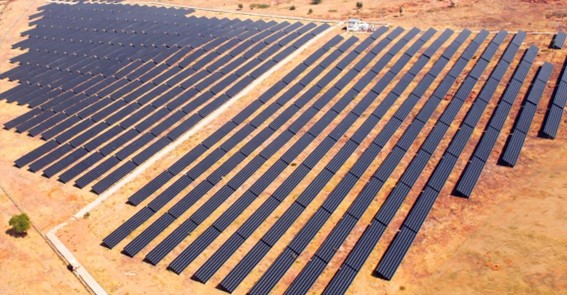
The world’s largest solar panel array is the facility in Bhadla, Rajasthan, India. Image: Azure Power
The world’s largest solar farm covers an area of 56 square kilometres in the Thar Desert near Bhadla, Rajasthan, India.
With a stated capacity of 2,245 megawatts, it reduces greenhouse gas emissions by an estimated 4 million tons annually. The farm consists of arrays installed by sixteen developers at a cost exceeding $2 billion, and uses robotic cleaning equipment to keep the panels clear of desert dust accumulation.
Construction is underway at the Wellington and Wellington North Solar Farms in New South Wales, Australia. Both are projects of an equal joint venture between petroleum company bp and Lightsource called Lightsource bp, full control of which bp has recently announced it intends to acquire. When operational, the two solar farms are expected to produce a combined 625 megawatts of electricity, which is enough to power 225,000 homes.

The Solar Milagres facility near Abaira, Brazil began producing 212 MW of electricity at the end of 2023. Image: Lightsource bp.
Lightsource bp’s Solar Milagres facility near Abaira, Brazil began operation at the end of 2023.
Covering an area of 387 hectares, the farm has a capacity of 212 MW which Lightsource bp says is equivalent to removing 57,000 gasoline and diesel vehicles from the road. However, large solar farms come with a host of concerns for the environment, wildlife, and human safety.
Prime among the environmental issues are the limited lives of the panels that generate the electricity and the batteries that store the power, and the resources required to manufacture, transport, maintain, and recycle the equipment. There are also occupational health and safety concerns for workers at the facilities who are exposed to ultraviolet radiation and physical hazards during installation and maintenance due to the size and height of the panels.
Biodiversity and animal habitats are significantly affected in the large areas covered by solar farms. A concern, known as the Lake Hypothesis Effect, is that birds in flight confuse solar panel arrays for water, causing them to divert and suffer fatality when they attempt to land on the panels. The US Geological Survey is now conducting a study on this hypothesis as well as the effects of other renewable energy technologies, particularly wind turbines, on wildlife.
What’s next for efficient energy from the sun?
As the generation of electricity from the sun becomes even more efficient through the use of perovskite and other materials, further cost reductions will make solar even more attractive and practical for home and industrial use. It will also contain or reduce the size of solar farms and their effects on the environment, wildlife, and human safety.
A potentially very significant outcome could be the use of solar energy to further another renewable technology, hydrogen fuel cells, by electrolysis.
Our feature on hydrogen fuel cells highlights the main challenge to producing environmentally friendly hydrogen fuel for vehicles and other uses is the process of splitting hydrogen atoms from either methane or water molecules. Most hydrogen is now produced from methane, which releases major quantities of the greenhouse gas carbon dioxide. The alternative, separating hydrogen from oxygen in water molecules, is an extremely energy-intensive process for which the use of solar energy could provide a significant benefit.
There’s no doubt that nearly two hundred years of developing technology to convert the power of the Sun into electricity promises a bright future for clean energy. Recent breakthroughs with highly efficient materials demonstrate that we can transform even more of the energy of the star that’s 150 million kilometres from Earth to power our technological, industrial world. The increase in vast solar energy farms and rapid decrease in the cost of producing solar power are already propelling us away from fossil fuels and toward a sustainable future.
We would love to hear what you think of this article.
☞ Click here to complete our 2-minute Reader survey.
Craving more information? Check out these recommended TQR articles:
- Progress in Superconductivity Holds Promise for Clean Energy, Medicine, Quantum Computing, and More
- Advances in Nuclear Fusion Technology are Fueling the Dream of Limitless Clean Energy
- Clean Technologies and Technologies That Clean: Undoing the Climate Damage We Have Caused
- Harnessing Ocean Power: New Technologies Hold Promise for Clean and Cost-Effective Energy
- In Wiki Loves Earth Photos, Observers Share a Deep Knowledge of Nature’s Incredible Integration



